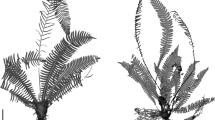Abstract
The morphology of conidia in 211 species and 12 varieties belonging to the genus Penicillium Link ex Gray have been studied and compared.
According to surface ornamentation, conidia have been classified into six groups: A, smooth-walled (7% of the species); B, delicately roughened (13%); C, warty (28%); D, echinate (10%); E, striate with low irregular ridges (36%); and F, striate with scarce high ridges or bars (6%). Whereas the first two groups are closely related in both shape and average size, a gradual reduction was observed in size and in the length/width (l/w) ratio in the remaining groups. Echinate conidia were globose, having the largest average size. Only four species produced conidia not surpassing 2 μm in diameter. Maximum length observed was 8 μm, and most elongated conidia had a l/w ratio of 3.5. Forty per cent of the species studied had globose conidia.
Conidia of the monoverticillate species were generally smaller, more globose and frequently with ridges. In the Asymmetrica, the conidia were generally larger, and showed ridges in comparatively few species. Conidia of the Symmetrica, which were frequently striate with ridges, presented the most elongated forms. The largest average size was found in the conidia of the Polyverticillata which were generally warty. Finally, we have considered the variations in surface ornamentation of conidia during the evolution of the genus Penicillium and drawn attention to their possible relationship with certain habitats and ways of conidial dispersion.
Similar content being viewed by others
References
Abe, S. 1956. Studies on the classification of the Penicillia.— J. Gen. Appl. Microbiol. (Tokyo) 2: 1–344.
Al-Musallam, A. 1980. Revision of the black Aspergillus species. Thesis.—State University of Utrecht.
Bartroli, M. 1980. Estudio de la micoflora superficial del río Anoia. Thesis.—University of Barcelona.
Calvo, M. A. 1978. Contribución al estudio de la micoflora atmosférica de la ciudad de Barcelona. Thesis.—University of Barcelona.
Cole, G. T. 1981. Architecture and chemistry of the cell wall of higher fungi.— Microbiology (Washington) 50: 227–231.
Cole, G. T. and Ramirez-Mitchel, R. 1974. Comparative scanning electron microscopy of Penicillium conidia subjected to critical point drying, freeze-drying and freeze-etching. p. 367–374. In Proceedings, Workshop on SEM and the Plant Sciences.—IIT Research Institute, Chicago.
Cole, G. T. and Samson, R. A. 1979. Patterns of development in conidial fungi.—Pitman Publ. Ltd., London.
Cole, G. T., Sekiya, T., Kasai, R., Yokoyama, T. and Nozawa, Y. 1979. Surface ultrastructure and chemical composition of the cell walls of conidial fungi.— Exp. Mycol. 3: 132–156.
Domsch, K. H., Gams, W. and Anderson, T. H. 1980. Compendium of soil fungi.—Academic Press, London.
Hess, W. M., Sassen, M. M. A. and Remsen, C. C. 1968. Surface characteristics of Penicillium conidia.— Mycologia 60: 290–303.
Malloch, D. and Cain, R. F. 1972. The Trichocomataceae: Ascomycetes with Aspergillus, Paecilomyces and Penicillium imperfect states.— Can. J. Bot. 50: 2613–2628.
Martinez, A. T. and Ramirez, C. 1981. Contribution to the preparation techniques of conidia for scanning electron microscopy. P 66.—Abstracts of the IV International Conference on Culture Collections, Brno.
Pitt, J. I. 1980. The genus Penicillium and its teleomorphic states Eupenicillium and Talaromyces.—Academic Press, London.
Ramirez, C. 1982. Manual and atlas of the Penicillia.—Elsevier Biomedical Press, Amsterdam (in press).
Raper, K. B. and Thom, C. 1949. A manual of the Penicillia.—Williams and Wilkins Co., Baltimore.
Samson, R. A. and Stalpers, J. A. 1978. Preparation techniques of fungal specimens for scanning electron microscopy.— Ultramicroscopy 3: 140.
Author information
Authors and Affiliations
Rights and permissions
About this article
Cite this article
Martinez, A.T., Calvo, M.A. & Ramirez, C. Scanning electron microscopy of Penicillium conidia. Antonie van Leeuwenhoek 48, 245–255 (1982). https://doi.org/10.1007/BF00400384
Received:
Issue Date:
DOI: https://doi.org/10.1007/BF00400384




